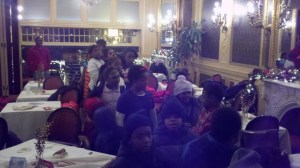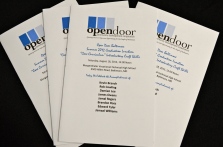The Missing Front
Since 2006, Open Door Baltimore has been searching for the front lines in America’s war on poverty.
If ever an organization was wired to lead from the trenches, it is this small innovative nonprofit from the tough streets of East Baltimore. Its DNA is perfect. Encoded in its vision and leadership are the chromosomes of faith, family, and free enterprise. All equal partners, none more important than the other.
But where are the front lines? Where is the fight being waged?
Eight years in, there is no front in sight. Like the war in Vietnam, there is no advancing edge, only scattered base camps from which insurgencies start, sputter, and then retreat for another day. There is no central controlling authority. No national or local strategy. At best, there are a handful of disconnected flanks that seldom move in the same direction or aspire to the same goal.
America’s poverty problem is getting worse each year, not because the poor cannot be helped but because the non-poor are erratic, disconnected, and generally non-cooperative in their efforts. There is a lack of will and courage on the part of our leaders. There is a corresponding preoccupation with instant gratification and cultural silliness on the part of the masses that prevents them from being led on issues of profound national importance. There is a lack of basic understanding about the horrific consequences of unabated intergenerational poverty. There is a pervasive ignorance on the part of most Americans about the causes of poverty and the total costs of its related social ills. And, there is a cavalier aloofness among many prosperous Americans about the “other America” that is surreptitiously sowing the seeds of decline for a great nation.
On March 3, 2013, the Baltimore Sun reported on the city government’s decision to close down a homeless encampment near the Jones Falls Expressway, a major commuter artery into the downtown business district. Posted with the story were scores of ill-conceived comments from online readers about the embarrassment of homelessness at the entrance to a great American city and the personal failure of low-order people who had fallen into homelessness. Sadly, the opportunity to engage in reflective thinking and purposeful analysis was undermined by a growing twenty-first-century instinct to engage in nanosecond exchanges without context or reason. More tragically, in a city of 488 church buildings and 24 synagogues, solutions for Baltimore’s 4,000 nightly homeless should have been embraced long ago.
In October 1965, at the high water mark of the American civil rights movement, Dr. Martin Luther King, Jr. stated that “what man has torn down, he can rebuild.” King was addressing a buoyant nation that had just ended 68 years of segregation and Jim Crow while also giving the vote to an entire race of previously disenfranchised people. He was anticipating a country that would soon see the greatest five-year decline in poverty in its history. This was an America of “can-do” optimism, of the pending moonshot, and of a blossoming suburbia. An America fueled by lofty goals and expansive dreams nurtured by the shared experience of two world wars, a Great Depression, and a Cold War threat that kept other national differences in check. King and others could not have envisioned a twenty-first-century America in which the nation’s unity and purpose would be so fragmented and diluted by fifty years of missed opportunities. King’s hopes for a renewed nation that would build upon the legislative achievements of 1964 and 1965 haplessly slipped into the mist of history when unforeseen leaders and events redirected the course of the nation.
Past as Prologue
In 1958, in the midst of a booming post-Great Depression, post-World War Two, and post-Korean War economy, nearly one in four Americans (22.4%) lived in poverty. In what is understood to be the most prosperous American decade of the twentieth century, the United States was incapable of lifting a quarter of its citizens out of poverty.
Thanks in large measure to the strong wartime economy of the 1960’s and unprecedented government involvement in poverty programming during the Lyndon Johnson Administration (1963-1969) and Richard Nixon Administration (1969-1974), the U.S. poverty rate reached a record low of 11.1% in 1973.
Due to high inflation, high interest rates, worldwide oil market price spikes, and the changing political landscape of the late 1970’s and early 1980’s, the U.S. poverty rate climbed to 15.2% in 1983 where it has remained largely unchanged for the past thirty years.
In 2013, 49 million people live in poverty, roughly 15.2% of the nation, one in every seven Americans. Included in this human catastrophe are 16.2 million children under the age of 18. Across the board, the poverty numbers look like this:
27.4% of African-Americans
26.6% of Hispanic-Americans
12.1% of Asian-Americans
9.9% of non-Hispanic whites
22.% of all children under the age of 18
38.2% of African-American children
35.0% of Hispanic-American children
13.6% of Asian-American children
12.4% of non-Hispanic white children
31.6% of households headed by single women
15.8% of households headed by single men.
The Greater Good
In its search for the front lines of a contemporary war on poverty, Open Door Baltimore has always looked to the past for valuable lessons and to the future for grand possibilities. It is the present where so much is inexplicably broken and dysfunctional. Throughout its first decade, Open Door Baltimore has worked to create an organizational culture where people from all walks of life can come together to make a difference in the fight against poverty. It has always been the company goal to pursue “the greater good” in partnership with private citizens, businesses, government agencies, other nonprofits and the faith community.
From the beginning, the Open Door Baltimore message has never wavered:
The status quo of entrenched intergenerational poverty can no longer be acceptable in the greatest and most prosperous nation on earth. Whatever the causes of the poverty and whomever the impoverished, poverty passed down from grandfather to father and father to son is antithetical to the American dream, morally indefensible, and counter to the best interests of all Americans.
The Empty Shell
Located in historic East Baltimore seven blocks northeast of Johns Hopkins Hospital, Open Door Baltimore has made the calculated decision to dig in and play for the long haul. Such are the gritty decisions of clear-eyed, street-level practitioners who value relationships over metrics, insight over spreadsheets, and hard-won progress over easy platitudes. Open Door Baltimore’s inclination to stare down the ugly truths of Baltimore is not always affirmed by elected officials and grant makers who hold disproportionate sway in the city’s minimalist poverty initiatives but it must be the deoxyribonucleic acid for any organization that is serious about changing the poverty discussion in the city.
One thing seems certain: as long as Baltimore’s leaders are content to stay hold up inside their “silos” where the name of the game is the perpetuation of their particular argument and angle, there can be no comprehensive and sustainable response to the city’s growing poverty problem. What was once applied by President George W. Bush to America’s educational deficiencies is equally applicable to Baltimore’s economic and workforce development industries. That is to say, one of the major causes of persistent unemployment and underemployment among the city’s disadvantaged is “the soft bigotry of low expectations.”
Too often, Baltimore employment programs train people for jobs that do not actually exist. This occurs for two reasons: (1) such programs are funded and staffed to perform this training and so the show must go on; and, (2) city leaders have no viable plan in motion to recruit good-paying, self-sustaining jobs to the poor sections of the city.
Until the jobs arrive, what are we training for? Asked another way, how many training sessions must there be on the topic of wearing a belt and a clean shirt to an interview? “Soft-skills” training is certainly important to the development of a new job readiness client but what is far more important to the success of the city is job training for living-wage jobs that actually exist, or are on their way, because a light manufacturing company from another state or country has been recruited to bring its 250 jobs to East or West Baltimore.
Is it any wonder that the city’s job readiness programs have so little appeal to the young men on the corners? The very target for most of the solutions needed in the city is hardly on the radar screen. And, yet, through their own entrepreneurial, albeit illicit activities, they have demonstrated to anyone who knows the streets that their time and energy is worth far more than a nine-dollar-an-hour job with no benefits emptying garbage cans or sweeping floors. This is the bull’s eye on the target. The success of the city is tied to jobs: jobs with living wages, career arcs, and personal dignity.
Much to its own peril, Open Door Baltimore has never taken the easy course, never played for the short gain, and never lost sight of the grim realities of the streets. In the poorest neighborhoods of Baltimore where economic necessity breeds violence and social chaos, there are no quick fixes and no simple answers, no matter how badly a funder, bureaucrat or stakeholder wants to make it so. To insist upon “instant rice” outcomes in neighborhoods saturated in intergenerational poverty is to badly misinterpret the unmistakable evidence of individual despair and collective isolation that has settled upon the children and grandchildren of Baltimore’s chronically unemployed and socially quarantined citizens.
To Be Continued . . .
Copyright © Open Door Baltimore 2012




